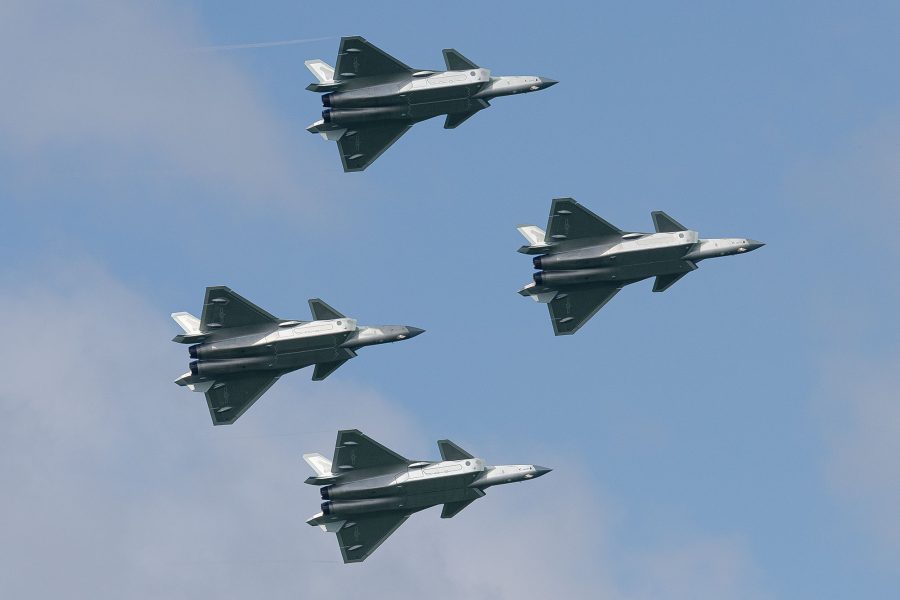It has been known and publicly acknowledged for several years now that China has surpassed the U.S. Navy in sheer number of warships. But in recent testimony on Capitol Hill, the head of U.S. Indo-Pacific Command suggested China may also have world’s largest air force soon, a surprising assessment of their rapid modernization efforts.
“The world’s largest Navy, soon to be the world’s largest Air Force,” Navy Adm. John C. Aquilino said, referring to the People’s Liberation Army, before the Senate Armed Services Committee on March 21. “The magnitude, scope, and scale of this security challenge cannot be understated, all would be challenged.”
An INDOPACOM spokesperson confirmed to Air & Space Forces Magazine that Aquilino was referring to the number of warplanes each country’s military possesses.
In its 2023 report on Chinese military power, the Pentagon noted that the PLA Air Force and Navy combined have over 3,150 total aircraft, not counting trainer variants and unmanned aircraft systems (UAS). The U.S. Air Force, by comparison, is at its smallest size in years but still has around 4,000 non-trainer, non-drone aircraft. That’s in addition to several thousand more in the Navy, Marine Corps, and Army.
Airpower and China experts expressed doubt that China would imminently overtake the U.S. in military aircraft. However, they did highlight China’s significant overall production capacity ramp-up in recent years, specifically for their cutting-edge fighters.
“The J-20 is now being produced at over roughly 100 airframes per year,” Daniel Rice,
China military and political strategy subject matter expert at the Krulak Center for Innovation and Future Warfare told Air & Space Forces Magazine. “That’s purely for indigenous consumption, for supplying the PLA Air Force with J-20 airframes. If you look at production capacity, the F-35, roughly 135 airframes per year, but 60 to 70 of those airframes are going to allies and partners.”
Rice noted, though, that the J-20 and F-35 should not be compared one-to-one.
“They have different mission sets and capabilities,” Rice added. “We like to say that the J-20 is roughly a 4.5-generation aircraft because there are different definitions of ‘generations’ between China and the U.S.”
This quality-versus-quantity assessment also comes into play when comparing the naval fleets of the two countries, as experts argue that while China may have more ships and submarines, the tonnage of America’s naval fleet surpasses that of China by a 2-to-1 ratio due to the larger size of U.S. vessels.
On the air side, China is accelerating its production of the J-16, J-10, and its sea variants as well. The J-16, a multi-role fighter, has more than 100 airframes produced annually, while the J-10’s production is around less than 40 airframes per year. But again, the J-10C is not quite the USAF’s F-15EX, and is rather “the low-end, or high-low mix of that version,” Rice said.
Yet, if production rate increases as anticipated, China may surpass the U.S. in producing their latest fighter aircraft. Rice noted that China’s development of an indigenous engine and reduced reliance on Russian-built engines have accelerated their combat aircraft production.
“With the WS-10 and WS-15 series engines, China has been able to produce a credible and reliable engine for their combat aircraft, namely J-10C and J-20,” Rice said. “Since this supply chain shift, and in conjunction with increasing production capacity for their airframes, we have seen different production facilities such as Shenyang Aircraft Corporation and Chengdu Aircraft Corporation, increase the size of their production facilities in anticipation of more throughput.”
Regional influence is another consideration in comparing fleet sizes. In his separate written testimony to lawmakers, Aquilino stated that the PLA Air Force and Navy combined constitute “the largest aviation forces in the Indo-Pacific.” While the U.S. is set to retain its long-range superiority, China’s regional dominance carries strategic concerns, especially in a scenario where it attempts to take Taiwan by force.
“China doesn’t need tankers, because it just doesn’t have to go that far,” J. Michael Dahm of the Mitchell Institute for Aerospace Studies told Air & Space Forces Magazine. “China doesn’t need a Global Hawk that can fly for over 24 hours. It may just need drones, retro-fitted, older aircraft that can fly 100 miles across the Taiwan Strait on a one-way trip.”
U.S. airpower is also spread across the globe, with missions in Europe, the Middle East, and the homeland.
And while the China military power report excluded drones from its aircraft count, they could play a crucial role in future assessments of military power projection. China is modernizing on that front too, with the recent introduction of the Xianglong jet-powered UAS, the supersonic WZ-8, and the redesigned GJ-11 stealth Unmanned Combat Air Vehicle (UCAV).
“In an age when we’re increasingly concerned about artificial intelligence, I would say that when we start counting unmanned aircraft, it could also quickly tip the scales in China’s favor,” Dahm said.
